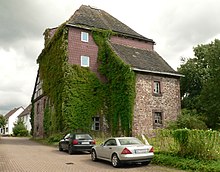Johann Christoph Glaser

Johann Christoph Glaser (born May 23, 1684 in Bischofsgrün ; † after 1753) was a German glass and porcelain painter and an alleged arcanist .
Life
Glaser was a member of a traditional glassmaker and glass painter family from Lauscha . In 1712 he married Barbara Wanderer and was therefore related to another important family of the guild. Initially, Johann Glaser also worked as a glass painter , but then tried his hand at arcanism, for example in Ilmenau from 1738 to 1740 and in Bayreuth in 1742 .
In 1744, Duke Carl I of Braunschweig contacted Glaser to commission him to found a porcelain factory. The deal did not materialize. Two years later it was Glaser who in turn visited the chief hunter Johann Georg von Langen in Bevern Castle and offered him his services. As proof of his skills in porcelain production, he is said to have presented unmarked porcelain from the Meissen porcelain factory and issued it as his own work. Contrary to the wishes of Glaser, who would have preferred to settle in Holzminden , von Langen proposed to the Duke that the porcelain factory be set up in Fürstenberg . Carl I. made the Fürstenberg Palace available for this purpose in early 1747 . As the technical director of the Fürstenberg porcelain factory , Johann Christoph Glaser was given the old mill in Fürstenberg as his home and laboratory.

It took almost three years until January 1750 that the first fire could be started in Fürstenberg. Although von Langen's first assessment of the product quality was still positive, it soon became apparent that Glaser actually had no knowledge of correct porcelain production: Instead of feldspar and kaolin , he used Emmerstedt clay and neither paint, glaze nor painting could stand up to comparison with Meissen porcelain .
In 1753 he was dismissed in Fürstenberg after he had not succeeded in making porcelain despite many promises and unsuccessful attempts. Nothing is known about his further life.
literature
- Thomas Kellmann: "The smoking castle" on the Weser. Fürstenberg: Castle - Palace - Manufactory - Museum. A history of construction and use in four acts. In: Lower Saxony Monument Preservation 1993–2000. 2001, Volume 16, pp. 260-289.
- Glaser, Johann Christoph . In: General Artist Lexicon . The visual artists of all times and peoples (AKL). Volume 56, Saur, Munich a. a. 2007, ISBN 978-3-598-22796-7 , p. 31. ( books.google.de ).
- Christian Scherer : The Fürstenberg porcelain. Reimer, Berlin 1909, pp. 1-6 ( Textarchiv - Internet Archive ).
| personal data | |
|---|---|
| SURNAME | Glaser, Johann Christoph |
| ALTERNATIVE NAMES | Glaser, Johann Christof; Glaser, Johann Christian |
| BRIEF DESCRIPTION | German glass and porcelain painter |
| DATE OF BIRTH | May 23, 1684 |
| PLACE OF BIRTH | Bischofsgrün |
| DATE OF DEATH | after 1753 |